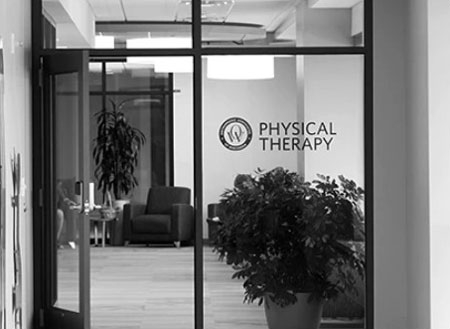
Today’s blog post is dedicated to the art of physical therapy (PT). Our ATI physical therapy department at our Pewaukee clinic is open from 7:00AM-7:00PM Monday through Thursday and 7:00AM-6:00PM on Fridays, so we have plenty of availability to accommodate our patients. We have a staff of seven Occupational Therapists, ten Physical Therapists, and three Physical Therapy Assistants to guide you through the healing process. One of the major benefits of coming to our clinic for your therapy needs is that our physicians work closely and regularly with all of our therapists. Sharing a building allows communication to flow regularly which allows continuous and comprehensive care.
Physical therapy can be one of the most helpful conservative treatments ordered by our board-certified physicians. If done correctly, PT can help correct muscle imbalances, improve posture, and decrease pain by improving overall function. Therapy is often ordered to improve range of motion and strength, decrease swelling, and desensitize an area.
Rehabilitating after surgery is when patients commonly find themselves in physical therapy. Early range of motion and strengthening exercises can help patients improve function and decrease pain sooner in the healing process. Our physical therapists have extensive knowledge regarding the ins and outs of each surgeon’s post-operative protocol for each procedure they perform. If setbacks occur along the way, your therapist may just pop over to clinic to chat things through with your surgeon so that you continue to progress appropriately.
What patients often do not realize is that sometimes prehabilitation is necessary before any surgical intervention is performed. For instance, people who sustain ACL injuries often participate in physical therapy to help decrease swelling in and around the knee as well as to strengthen the muscles that support the knee to give them a leg up after surgery. Other pathologies often trial a course of formal physical therapy because for a lot of patients, therapy resolves the problem without the risks of a surgery.
Non-operative physical therapy for both acute and chronic musculoskeletal issues is an immensely beneficial and integral part of orthopedic care. From strains to sprains to fractures, an exercise progression for stretching and strengthening will get you back to normal function sooner. After being immobilized in a cast, therapy will help activate all of those stiff muscles once again. After a hamstring strain, a progression of careful strengthening will allow you to progress while those muscle fibers heal. When ankle sprains occur repeatedly, some formal physical therapy will help with joint awareness, strengthening, and stabilization to prevent future injury.
Physical Therapy is one of those things your mom warned you about: you get out of it what you put into it. Physical therapists do not exist to do the work for you; rather, they are available to educate and help you to correctly perform the exercises. They monitor your status and progress you as your symptoms allow. It is your responsibility to be involved in your own care and to diligently perform the exercises at home as instructed. With dedication, physical therapy can improve even what seems like a severe musculoskeletal injury. Still don’t believe us? Call us at 262-303-5055 to schedule an appointment with one of our physicians to see what PT can do for you!
This blog is written by one of our very own-Morgan. She is a certified athletic trainer working as a medical assistant with our providers each and every day in our clinic. She obtained a bachelor's degree in athletic training from Carroll University in Waukesha and a master's degree in Kinesiology from Michigan State University. She is excited to bring you updates and information about the happenings at OAW.

